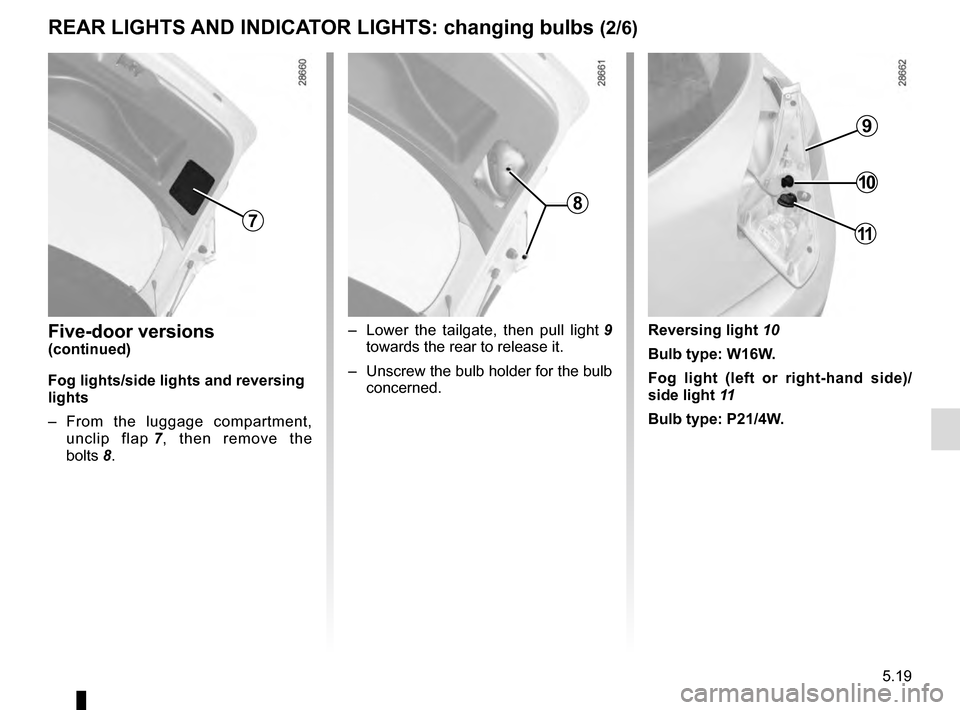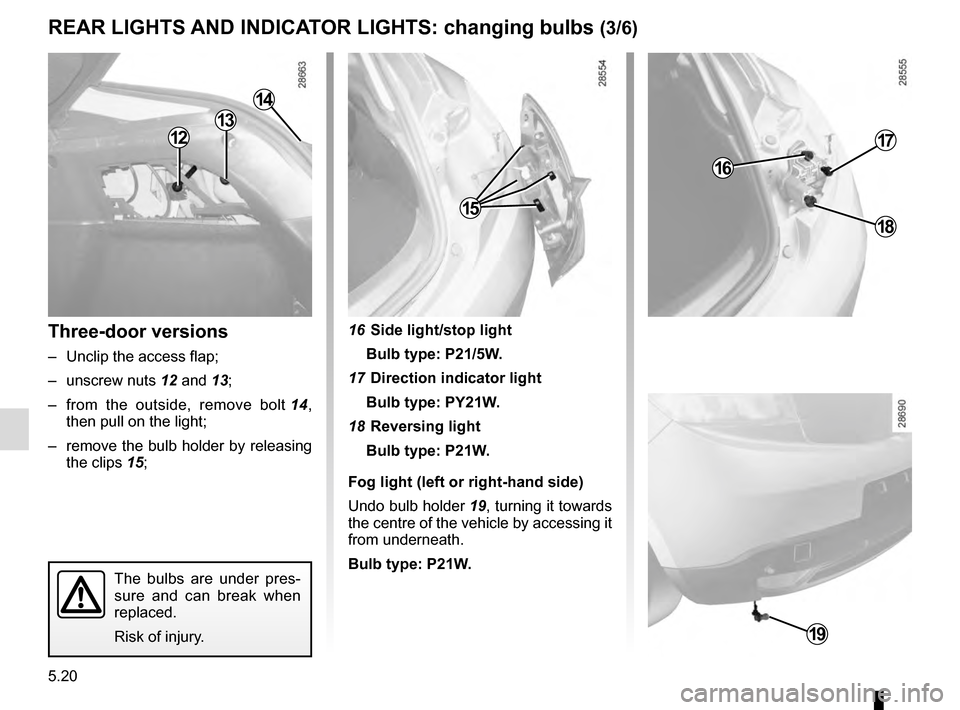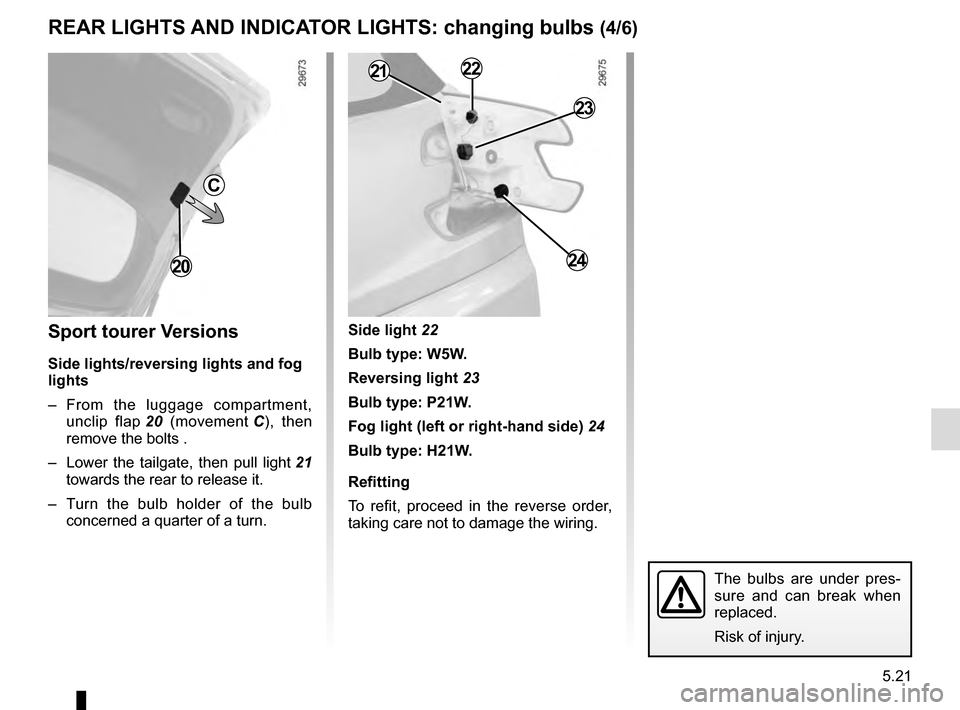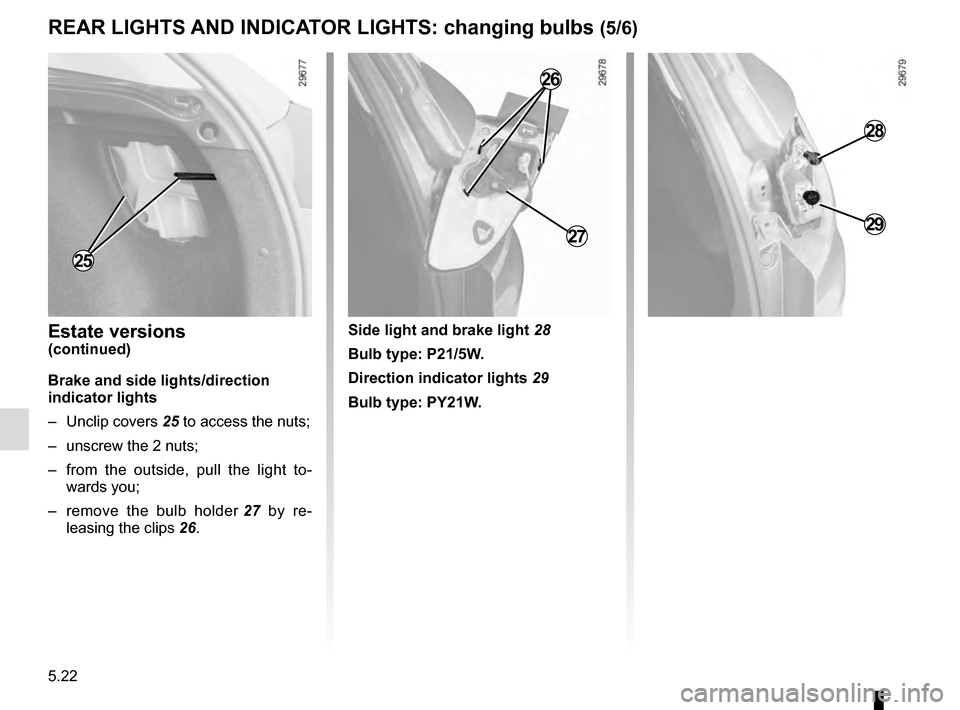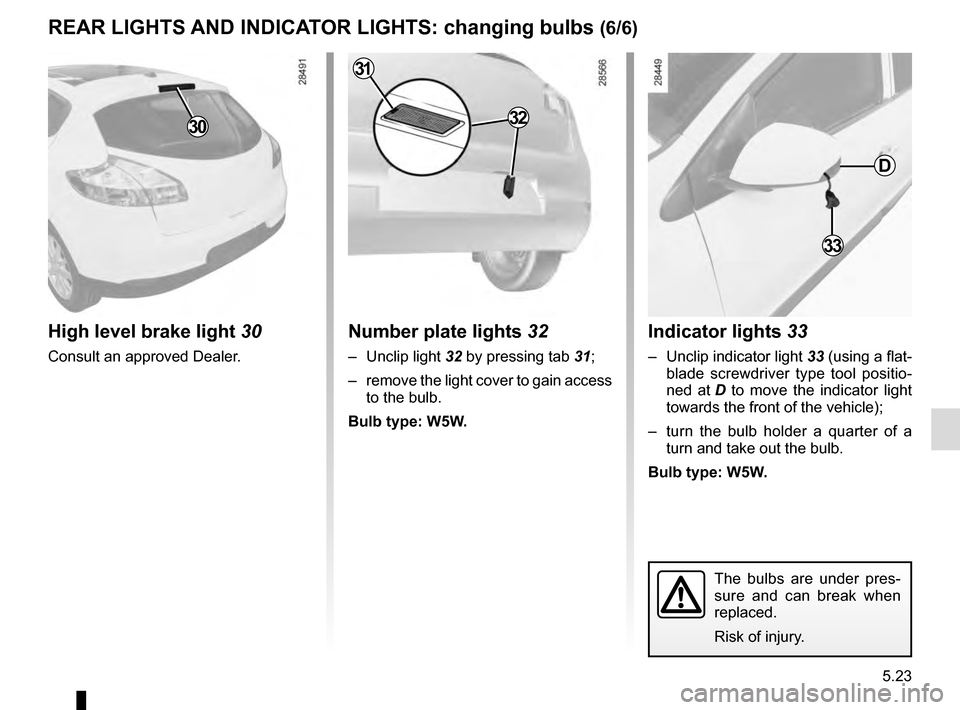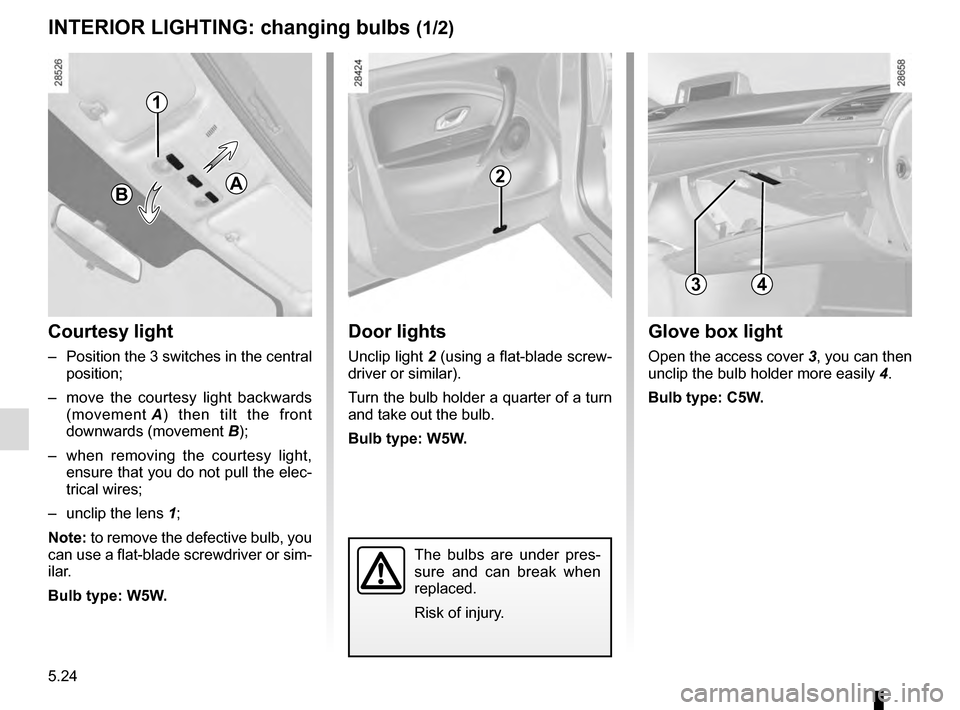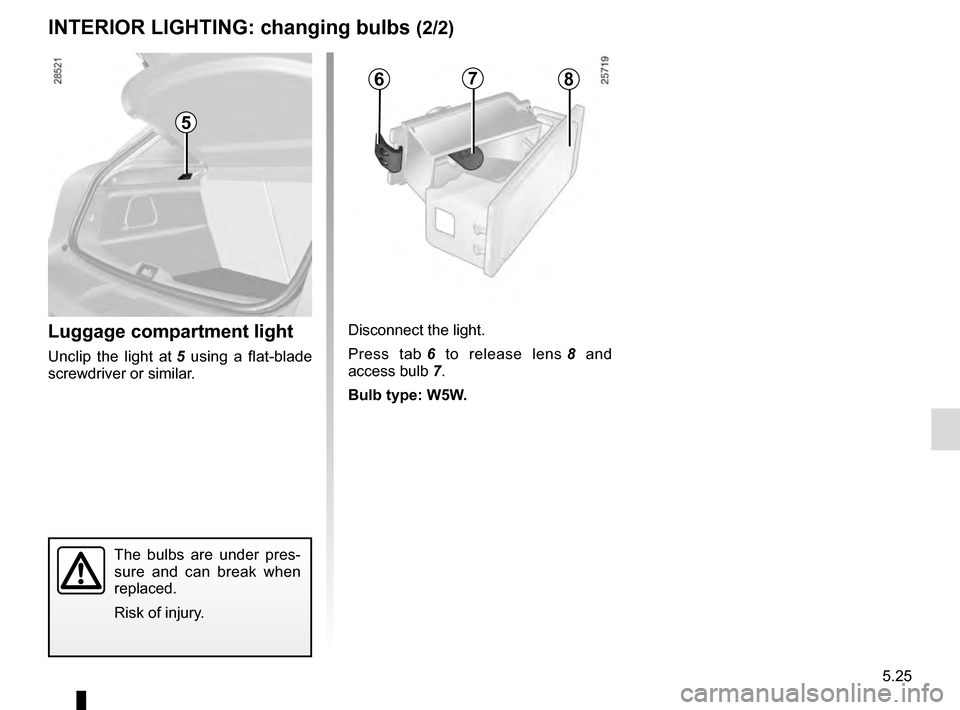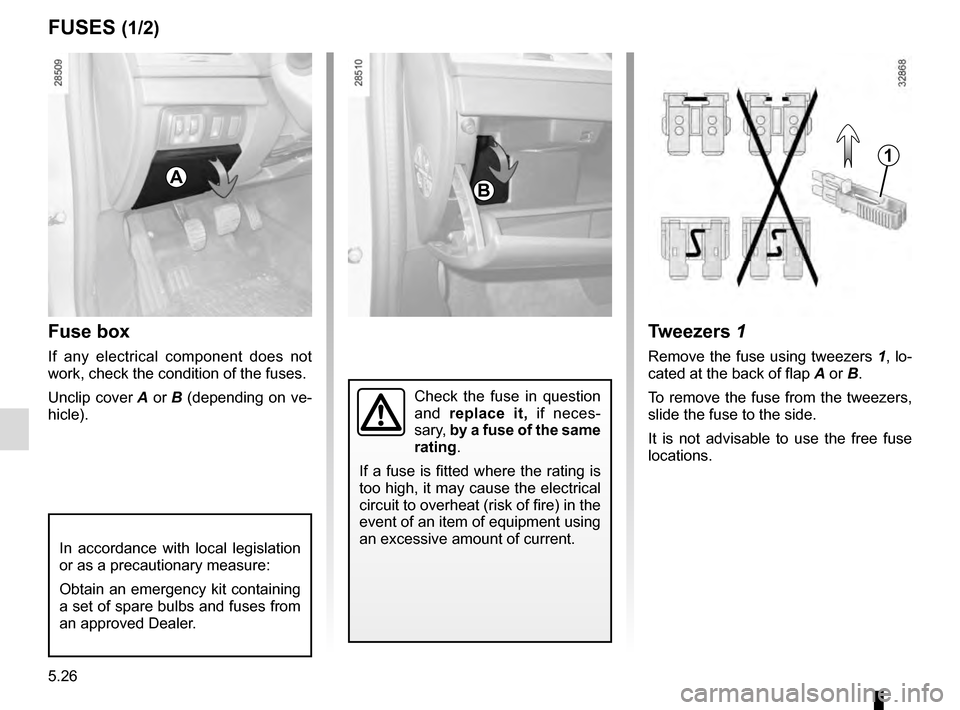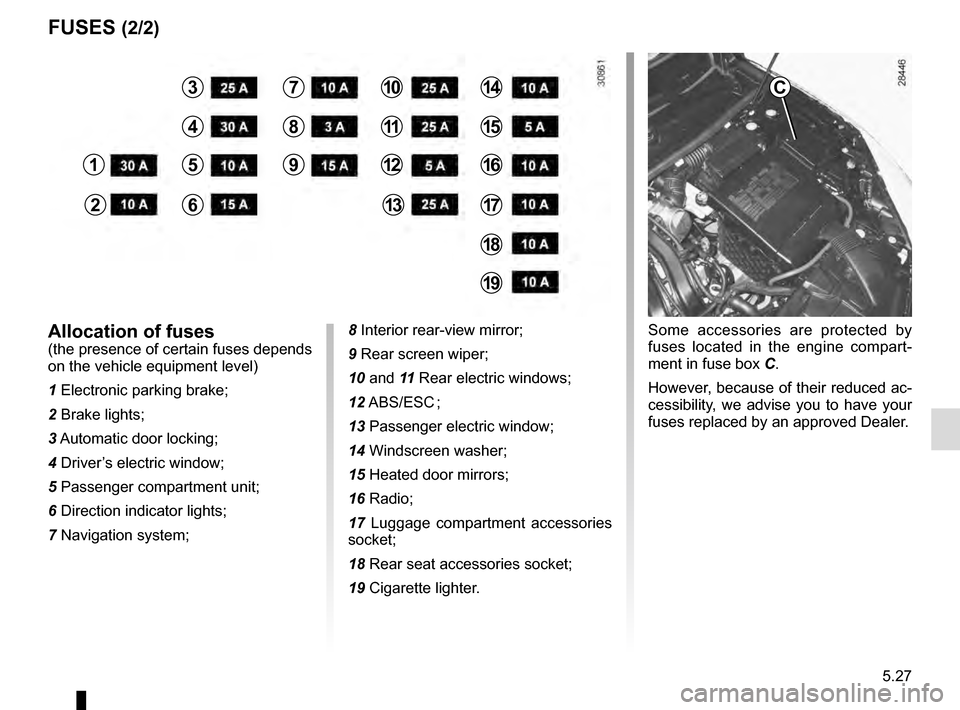RENAULT MEGANE ESTATE 2016 X95 / 3.G Owners Manual
MEGANE ESTATE 2016 X95 / 3.G
RENAULT
RENAULT
https://www.carmanualsonline.info/img/7/1620/w960_1620-0.png
RENAULT MEGANE ESTATE 2016 X95 / 3.G Owners Manual
Trending: airbag, check oil, Dipped light, change wheel, service interval, wheel bolts, Audible signals
Page 221 of 274
5.19
REAR LIGHTS AND INDICATOR LIGHTS: changing bulbs (2/6)
Five-door versions
(continued)
Fog lights/side lights and reversing
lights
– From the luggage compartment, unclip flap 7, then remove the
bolts 8.
– Lower the tailgate, then pull light 9
towards the rear to release it.
– Unscrew the bulb holder for the bulb concerned.
7
9
10
8
11
Reversing light 10
Bulb type: W16W.
Fog light (left or right-hand side)/
side light 11
Bulb type: P21/4W.
Page 222 of 274
5.20
Three-door versions
– Unclip the access flap;
– unscrew nuts 12 and 13;
– from the outside, remove bolt 14,
then pull on the light;
– remove the bulb holder by releasing the clips 15; 16 Side light/stop light
Bulb type: P21/5W.
17 Direction indicator light
Bulb type: PY21W.
18 Reversing light
Bulb type: P21W.
Fog light (left or right-hand side)
Undo bulb holder 19, turning it towards
the centre of the vehicle by accessing it
from underneath.
Bulb type: P21W.
The bulbs are under pres-
sure and can break when
replaced.
Risk of injury.
REAR LIGHTS AND INDICATOR LIGHTS: changing bulbs (3/6)
18
16
1712
13
14
15
19
Page 223 of 274
5.21
REAR LIGHTS AND INDICATOR LIGHTS: changing bulbs (4/6)
Sport tourer Versions
Side lights/reversing lights and fog
lights
– From the luggage compartment, unclip flap 20 (movement C), then
remove the bolts .
– Lower the tailgate, then pull light 21
towards the rear to release it.
– Turn the bulb holder of the bulb concerned a quarter of a turn.
20
Side light 22
Bulb type: W5W.
Reversing light 23
Bulb type: P21W.
Fog light (left or right-hand side) 24
Bulb type: H21W.
Refitting
To refit, proceed in the reverse order,
taking care not to damage the wiring.
C
21
23
24
The bulbs are under pres-
sure and can break when
replaced.
Risk of injury.
22
Page 224 of 274
5.22
REAR LIGHTS AND INDICATOR LIGHTS: changing bulbs (5/6)
28
29
Side light and brake light 28
Bulb type: P21/5W.
Direction indicator lights 29
Bulb type: PY21W.Estate versions(continued)
Brake and side lights/direction
indicator lights
– Unclip covers 25 to access the nuts;
– unscrew the 2 nuts;
– from the outside, pull the light to- wards you;
– remove the bulb holder 27 by re-
leasing the clips 26.
25
27
26
Page 225 of 274
5.23
REAR LIGHTS AND INDICATOR LIGHTS: changing bulbs (6/6)
Indicator lights 33
– Unclip indicator light 33 (using a flat-
blade screwdriver type tool positio-
ned at D to move the indicator light
towards the front of the vehicle);
– turn the bulb holder a quarter of a turn and take out the bulb.
Bulb type: W5W.
Number plate lights 32
– Unclip light 32 by pressing tab 31;
– remove the light cover to gain access to the bulb.
Bulb type: W5W.
High level brake light 30
Consult an approved Dealer.
30
22
2333
D
32
31
The bulbs are under pres-
sure and can break when
replaced.
Risk of injury.
Page 226 of 274
5.24
The bulbs are under pres-
sure and can break when
replaced.
Risk of injury.
INTERIOR LIGHTING: changing bulbs (1/2)
Courtesy light
– Position the 3 switches in the central position;
– move the courtesy light backwards (movement A) then tilt the front
downwards (movement B);
– when removing the courtesy light, ensure that you do not pull the elec-
trical wires;
– unclip the lens 1;
Note: to remove the defective bulb, you
can use a flat-blade screwdriver or sim-
ilar.
Bulb type: W5W.
Glove box light
Open the access cover 3, you can then
unclip the bulb holder more easily 4.
Bulb type: C5W.
Door lights
Unclip light 2 (using a flat-blade screw-
driver or similar).
Turn the bulb holder a quarter of a turn
and take out the bulb.
Bulb type: W5W.
2
4
BA
3
1
Page 227 of 274
5.25
The bulbs are under pres-
sure and can break when
replaced.
Risk of injury.
Luggage compartment light
Unclip the light at 5 using a flat-blade
screwdriver or similar. Disconnect the light.
Press tab
6 to release lens 8 and
access bulb 7.
Bulb type: W5W.
INTERIOR LIGHTING: changing bulbs (2/2)
5
678
Page 228 of 274
5.26
Fuse box
If any electrical component does not
work, check the condition of the fuses.
Unclip cover A or B (depending on ve-
hicle).
Tweezers 1
Remove the fuse using tweezers 1, lo-
cated at the back of flap A or B.
To remove the fuse from the tweezers,
slide the fuse to the side.
It is not advisable to use the free fuse
locations.
Check the fuse in question
and replace it, if neces-
sary, by a fuse of the same
rating.
If a fuse is fitted where the rating is
too high, it may cause the electrical
circuit to overheat (risk of fire) in the
event of an item of equipment using
an excessive amount of current.
FUSES (1/2)
AB
In accordance with local legislation
or as a precautionary measure:
Obtain an emergency kit containing
a set of spare bulbs and fuses from
an approved Dealer.
1
Page 229 of 274
5.27
FUSES (2/2)
Some accessories are protected by
fuses located in the engine compart-
ment in fuse box C.
However, because of their reduced ac-
cessibility, we advise you to have your
fuses replaced by an approved Dealer.Allocation of fuses(the presence of certain fuses depends
on the vehicle equipment level)
1 Electronic parking brake;
2 Brake lights;
3 Automatic door locking;
4 Driver’s electric window;
5 Passenger compartment unit;
6 Direction indicator lights;
7 Navigation system;8 Interior rear-view mirror;
9 Rear screen wiper;
10 and 11
Rear electric windows;
12 ABS/ESC ;
13 Passenger electric window;
14 Windscreen washer;
15 Heated door mirrors;
16 Radio;
17 Luggage compartment accessories
socket;
18 Rear seat accessories socket;
19 Cigarette lighter.
C
1
2
3
4
5
6
7
8
9
10
11
12
13
14
15
16
17
18
19
Page 230 of 274
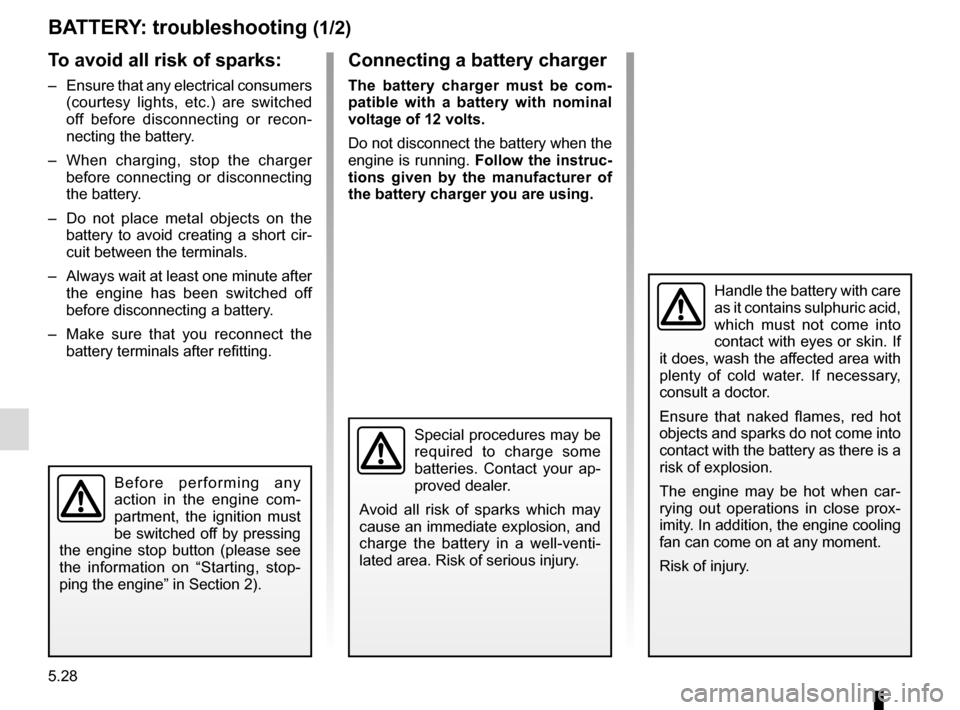
5.28
BATTERY: troubleshooting (1/2)
To avoid all risk of sparks:
– Ensure that any electrical consumers (courtesy lights, etc.) are switched
off before disconnecting or recon-
necting the battery.
– When charging, stop the charger before connecting or disconnecting
the battery.
– Do not place metal objects on the battery to avoid creating a short cir-
cuit between the terminals.
– Always wait at least one minute after the engine has been switched off
before disconnecting a battery.
– Make sure that you reconnect the battery terminals after refitting.
Connecting a battery charger
The battery charger must be com-
patible with a battery with nominal
voltage of 12 volts.
Do not disconnect the battery when the
engine is running. Follow the instruc-
tions given by the manufacturer of
the battery charger you are using.
Special procedures may be
required to charge some
batteries. Contact your ap-
proved dealer.
Avoid all risk of sparks which may
cause an immediate explosion, and
charge the battery in a well-venti-
lated area. Risk of serious injury.
Handle the battery with care
as it contains sulphuric acid,
which must not come into
contact with eyes or skin. If
it does, wash the affected area with
plenty of cold water. If necessary,
consult a doctor.
Ensure that naked flames, red hot
objects and sparks do not come into
contact with the battery as there is a
risk of explosion.
The engine may be hot when car-
rying out operations in close prox-
imity. In addition, the engine cooling
fan can come on at any moment.
Risk of injury.
Before performing any
action in the engine com-
partment, the ignition must
be switched off by pressing
the engine stop button (please see
the information on “Starting, stop-
ping the engine” in Section 2).
Trending: service indicator, fuel pressure, clock reset, radio, remote start, clutch, technical specifications
